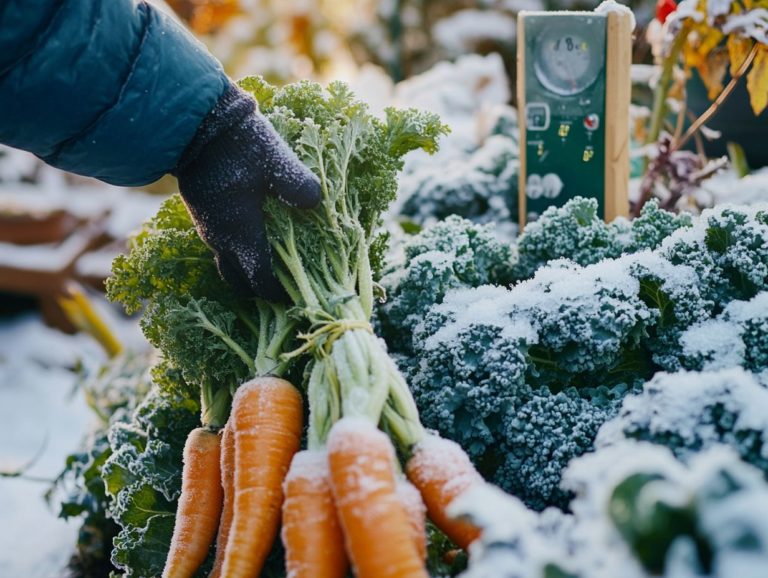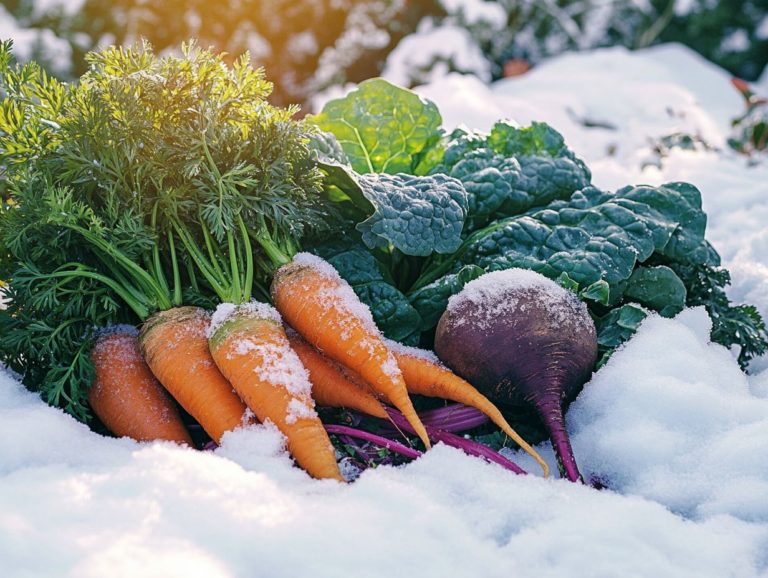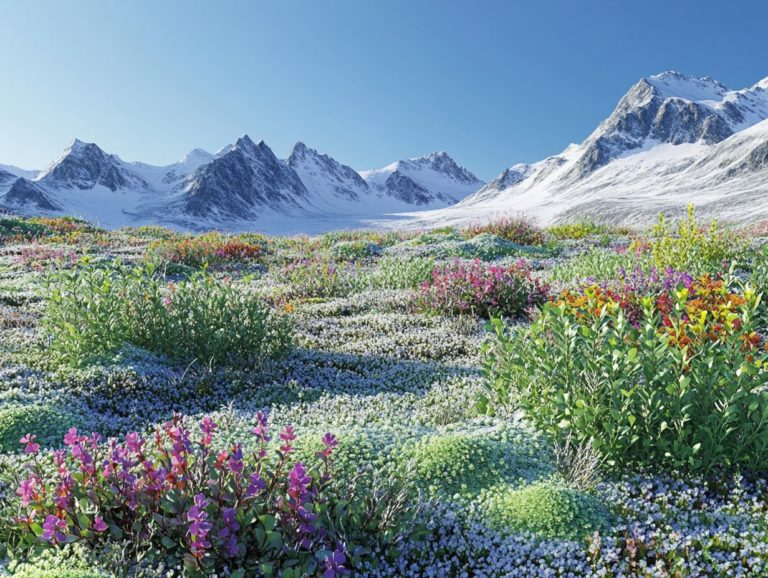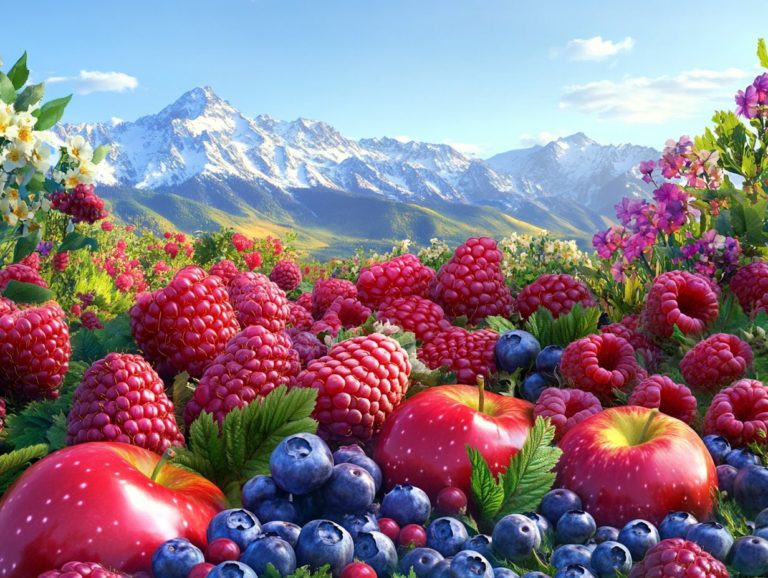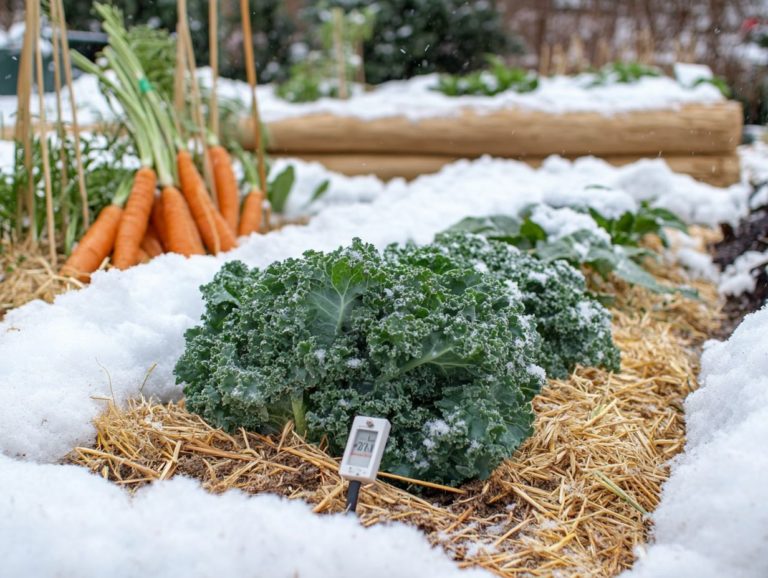What is the Best Soil for Cold-Climate Gardens?
Gardening in cold climates can be a thrilling adventure! With the right knowledge and tools, you can create a stunning garden even amid frost and snow.
This article delves into what distinguishes cold-climate gardening, highlighting essential factors such as soil composition and nutrient levels. It examines the types of soil that thrive in chilly environments and shares invaluable tips for preparing and maintaining your soil. Additionally, it provides guidance on selecting the ideal plants to ensure your gardening experience is nothing short of successful.
Discover how to maximize your cold-climate garden and turn those frosty challenges into exciting opportunities for growth!
Contents
- Key Takeaways:
- Understanding Cold-Climate Gardening
- Factors to Consider When Choosing Soil
- Climate and Temperature Considerations
- Soil Composition and Nutrient Levels
- Types of Soil Suitable for Cold-Climate Gardens
- Preparing and Maintaining Soil for Cold-Climate Gardens
- Tips for Successful Gardening in Cold Climates
- Frequently Asked Questions
- What is the Best Soil for Cold-Climate Gardens?
- What are the Benefits of Using Organic Matter in Cold-Climate Garden Soil?
- How Do I Improve Drainage in Cold-Climate Garden Soil?
- Can I Use Regular Potting Soil in a Cold-Climate Garden?
- What Should I Consider When Choosing Soil for a Cold-Climate Garden?
- Is It Possible to Grow a Successful Garden in Cold Climates?
Key Takeaways:

- Understanding the unique needs of a cold-climate garden is crucial for successful gardening.
- The right soil composition and nutrient levels are essential for plant growth and survival in cold climates.
- Proper soil preparation and maintenance, including improving drainage and using fertilizers, can help cold-climate gardens thrive.
Understanding Cold-Climate Gardening
Cold-climate gardening demands a tailored strategy, especially in regions like Wyoming, where brutal winters and abbreviated growing seasons present distinct challenges. By understanding the details of gardening in zone five, you can significantly improve your chances of success.
Employing techniques such as raised beds elevated garden plots that help with drainage and season extenders, tools like row covers that protect plants from frost, becomes essential for maximizing your yields in these conditions.
Understanding local frost dates and a map showing which plants grow best in your area helps you choose the most suitable heirloom seeds. This knowledge allows you to cultivate a flourishing garden despite the climatic hurdles.
What Makes Cold-Climate Gardening Different?
Cold-climate gardening presents distinct challenges that set it apart from other gardening practices, primarily due to unique environmental factors such as frost dates and shorter growing seasons, particularly in garden zone five. By grasping these differences, you can make informed choices about gardening techniques that align perfectly with your local conditions.
In these regions, the timing of frost dates is paramount in deciding when to sow seeds or transplant seedlings outdoors. For example, opting for heirloom varieties that mature quickly can significantly boost your chances of a fruitful harvest before the first frost arrives. Local gardening stores often boast knowledgeable staff who can guide you toward specific plants known to thrive in colder climates think hardy kale or early-blooming peas. They may also offer unique heirloom seeds tailored to your area’s microclimates.
By tapping into these localized resources, you position yourself to effectively tackle the challenges your environment presents. This enables you to cultivate a diverse range of plants throughout the growing season with confidence.
Factors to Consider When Choosing Soil
When you venture into cold-climate gardening, understanding the details of soil factors becomes essential for cultivating a thriving garden. Soil challenges, including drainage and nutrient levels, can significantly impact plant health and productivity, especially in unforgiving climates.
It’s crucial to take into account the variations in climate and temperature when choosing the appropriate soil composition. This ensures that your plants not only survive but thrive, even in the most extreme conditions.
Climate and Temperature Considerations
Understanding the nuances of climate and temperature is essential for achieving success in gardening in cold weather, especially when you’re planning for frost dates and seeking to extend your growing season. Temperature fluctuations can profoundly influence your choice of plants and the overall health of your garden.
In these regions, it’s vital to stay updated on your local frost dates, as this information directly affects when you should plant and when it’s time to harvest. Opting for hardy varieties that flourish in cooler conditions can significantly enhance your results. Crops like kale, onions, and certain types of squash thrive even when the chill sets in.
Using techniques such as row covers, cold frames, and cloches can effectively buffer against harsh conditions, providing an extra layer of protection for your sensitive seedlings. By planning your planting schedule and applying these methods, you can look forward to a more bountiful and extended growing season, despite the unpredictability of the weather.
Soil Composition and Nutrient Levels
Soil composition and nutrient levels are essential elements in your cold-weather gardening journey. They significantly impact plant growth and the overall success of your garden. By understanding how to amend your soil with compost and other organic materials, you can greatly enhance nutrient availability and promote thriving plant development.
Different soil types sandy, clay, and loamy each bring their unique characteristics. They affect water drainage, root penetration, and nutrient retention. In colder regions, choosing soils that retain warmth and moisture while providing adequate nutrients for plants is crucial, especially those contending with shorter growing seasons.
The art of compost making can dramatically improve your soil quality by enriching it with organic matter. This helps maintain moisture levels and creates a fertile environment. Start by layering kitchen scraps, garden waste, and other organic materials in a compost bin. Remember to turn the mixture regularly to promote aeration and hasten decomposition.
By integrating compost into your garden, you ll elevate nutrient levels significantly, resulting in robust and flourishing plants.
Types of Soil Suitable for Cold-Climate Gardens
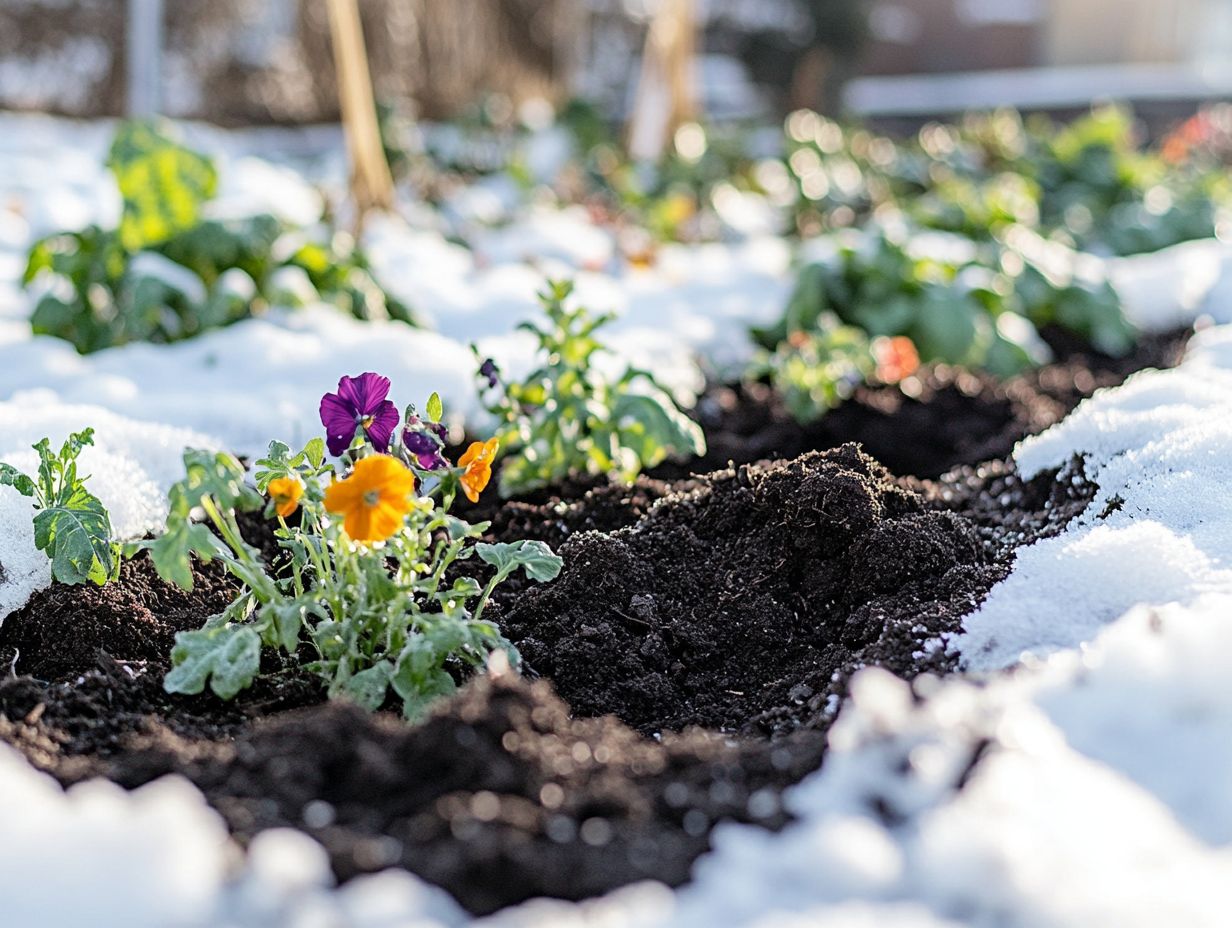
Choosing the right types of soil is essential for thriving in cold-weather gardening, as it directly influences plant health and productivity.
In areas with unforgiving climates, grasping the unique properties of various soil types such as topsoil, loam, clay, silt, and sand empowers you to make informed decisions, ultimately crafting the ideal conditions for your plants to flourish.
Topsoil
Topsoil is often seen as the cornerstone of cold weather gardening, brimming with the nutrients your plants need to thrive. Understanding how to enrich this vital layer can dramatically elevate your garden’s productivity, even in challenging conditions.
In regions where frigid temperatures and short growing seasons prevail, the quality of your topsoil becomes paramount for nurturing resilient plant life. This essential layer serves as a reservoir for moisture and crucial nutrients while providing a haven for beneficial microorganisms that enhance soil health.
To elevate your topsoil quality, think about incorporating organic amendments like well-decomposed compost. This addition brings essential nutrients and improves the structure of your soil.
- Consider adding materials such as aged manure or leaf mold to further enrich the soil, promoting better drainage and aeration.
- Regularly mulching your planting beds can protect your topsoil from erosion and gradually release organic matter as it breaks down, ensuring your garden thrives despite winter’s chill.
By prioritizing the health of your topsoil, you can cultivate a flourishing garden environment that stands strong against the challenges of winter.
Get started on your cold-weather garden today and watch it flourish!
Loam
Loam is often regarded as the ultimate soil type for cold climate gardening. It blends the advantages of sand, silt, and clay to provide exceptional drainage and fertility. Its well-balanced structure supports healthy root development and fosters impressive plant growth, even in harsh climates.
This versatile soil doesn t just hold onto moisture; it allows excess water to drain away. This protects against root rot while promoting vigorous plant health. Loam is a game-changer for gardeners in areas where freezing temperatures can stress their plants.
To cultivate loam-like qualities in your existing soils, incorporate organic matter such as compost or aged manure. This will enhance both structure and nutrient content. Regularly aerate the soil by making holes to help air and water reach the roots. This ensures your plants receive the support and moisture they need to flourish in demanding conditions.
Clay
Clay soil can present challenges when gardening in cold climates due to its dense structure and poor drainage. But it holds onto water well, which can be beneficial. By mastering the nuances of managing clay soil, you can achieve successful gardening outcomes even under less-than-ideal conditions.
As a gardener in these regions, you may grapple with issues like waterlogging in spring. This can stifle root growth and create a cozy haven for pests. The compaction of clay soil can restrict air circulation, making it tough for your plants to thrive.
To combat these challenges, incorporate organic matter like compost to improve soil structure and enhance drainage. Raised beds grant better moisture control and promote healthier root development. Select resilient plant varieties, such as native species, to optimize your success and ensure a bountiful harvest despite the hurdles posed by clay soil in colder climates.
Silt
Silt soil boasts a fine texture and remarkable nutrient retention, making it an excellent choice for your cold climate gardening endeavors. Its ability to retain moisture while allowing good drainage creates an ideal environment for healthy plant growth, even in challenging climates.
This unique soil acts as a buffer against temperature extremes, helping roots access essential nutrients more effectively. If you re gardening in colder regions, the beneficial properties of silt soil can greatly enhance your plants’ chances of surviving harsh winters.
To fully leverage its benefits, incorporate organic matter like compost or well-rotted manure. This can significantly improve soil structure, boost microbial activity, and elevate nutrient availability. Mulching helps keep moisture levels steady while regulating temperature fluctuations, creating an optimal environment for your garden to thrive.
Sand
Sand can play a vital role in cold climate gardening, primarily due to its remarkable drainage properties. However, it is nutrient-deficient compared to other soil types. By learning how to incorporate sand into your soil structure, you can enhance drainage and aeration, promoting healthier plant growth.
While adding sand prevents waterlogging during thawing periods, be cautious too much sand can create a dry and nutrient-depleted environment for your plants. To achieve balance, blend sand with organic matter like compost or peat moss.
This combination enhances nutrient availability and improves moisture retention, creating a more forgiving environment for plant roots. Incorporating clay into the mix can further enhance your soil structure, providing a harmonious blend that supports robust growth while maintaining the essential drainage benefits that sand offers.
Preparing and Maintaining Soil for Cold-Climate Gardens

Preparing and maintaining soil for cold-climate gardens requires a thoughtful approach to establish a thriving growing environment. You should prioritize enhancing drainage, developing the ideal soil structure, and selecting suitable fertilizers and amendments. These steps are crucial in fostering plant health and resilience, especially in challenging climates.
Improving Drainage and Insulation
Improving drainage and insulation in cold climate gardening is essential for overcoming soil challenges that can impede plant growth. Techniques like raised beds and proper soil amendments can enhance drainage.
They also safeguard plant roots from the rigors of harsh temperatures. Incorporating organic matter, such as compost, not only boosts soil structure but also stimulates beneficial microbial activity the activity of tiny organisms that help improve soil health, which is crucial for effective nutrient absorption.
If you’re looking to elevate your gardening game, utilizing raised beds can significantly enhance drainage and simplify the management of fluctuating soil temperatures.
Implementing insulation methods, like mulching with straw or wood chips, helps prevent heat loss, creating a more stable environment for your plants to thrive, even in the chill. Altogether, these strategies cultivate a healthier garden ecosystem, ensuring that your plants not only survive but truly flourish.
Boost Your Soil: Fertilizers and Amendments You Need
Utilizing fertilizers and amendments effectively is crucial for maintaining nutrient levels in cold climate gardening, where soil fertility often poses a challenge. By understanding the various types of fertilizers and their application methods, you can significantly enhance plant health and yields, even in harsh conditions.
As a gardener in these regions, you encounter unique challenges, such as shorter growing seasons and nutrient depletion from frost and snow. Incorporating organic options like compost and well-rotted manure can improve soil structure and moisture retention, fostering a more robust root system.
Synthetic fertilizers also have their place; they can deliver a rapid nutrient boost, especially nitrogen sources in early spring. Timing is key applying these nutrients just before planting ensures they are readily available as your plants embark on their growth cycle.
Specific amendments like lime can help balance soil pH, creating an ideal environment for your crops to thrive, despite the cold.
Tips for Successful Gardening in Cold Climates
Successful gardening in cold climates demands your meticulous planning and the application of techniques specifically designed for the unique challenges of such an environment. Start planning now for your best garden yet, even in the cold! By choosing the right plants and employing effective gardening strategies, you can create a lush, vibrant garden.
Choosing the Right Plants and Techniques
Choosing the right plants and techniques is crucial for cold climate gardening; selecting cold-hardy varieties and heirloom seeds can truly elevate your gardening experience. By implementing winter gardening methods, such as cold frames or hoop houses, you can significantly boost your garden’s productivity.
When deciding what to plant, it s essential for you to research varieties that thrive in lower temperatures. These resilient plants often require less maintenance, making your life easier.
Heirloom seeds, with their rich genetic diversity, not only increase your chances of a successful harvest but also help preserve unique flavors and characteristics.
Starting seeds indoors a few weeks before the last frost can give you a valuable head start. This strategy allows you to transplant sturdy seedlings when the weather finally permits.
Additionally, employing techniques like mulching and using row covers can extend your growing season, ensuring your garden remains vibrant even as temperatures dip.
Frequently Asked Questions
Get started today your garden awaits!
What is the Best Soil for Cold-Climate Gardens?
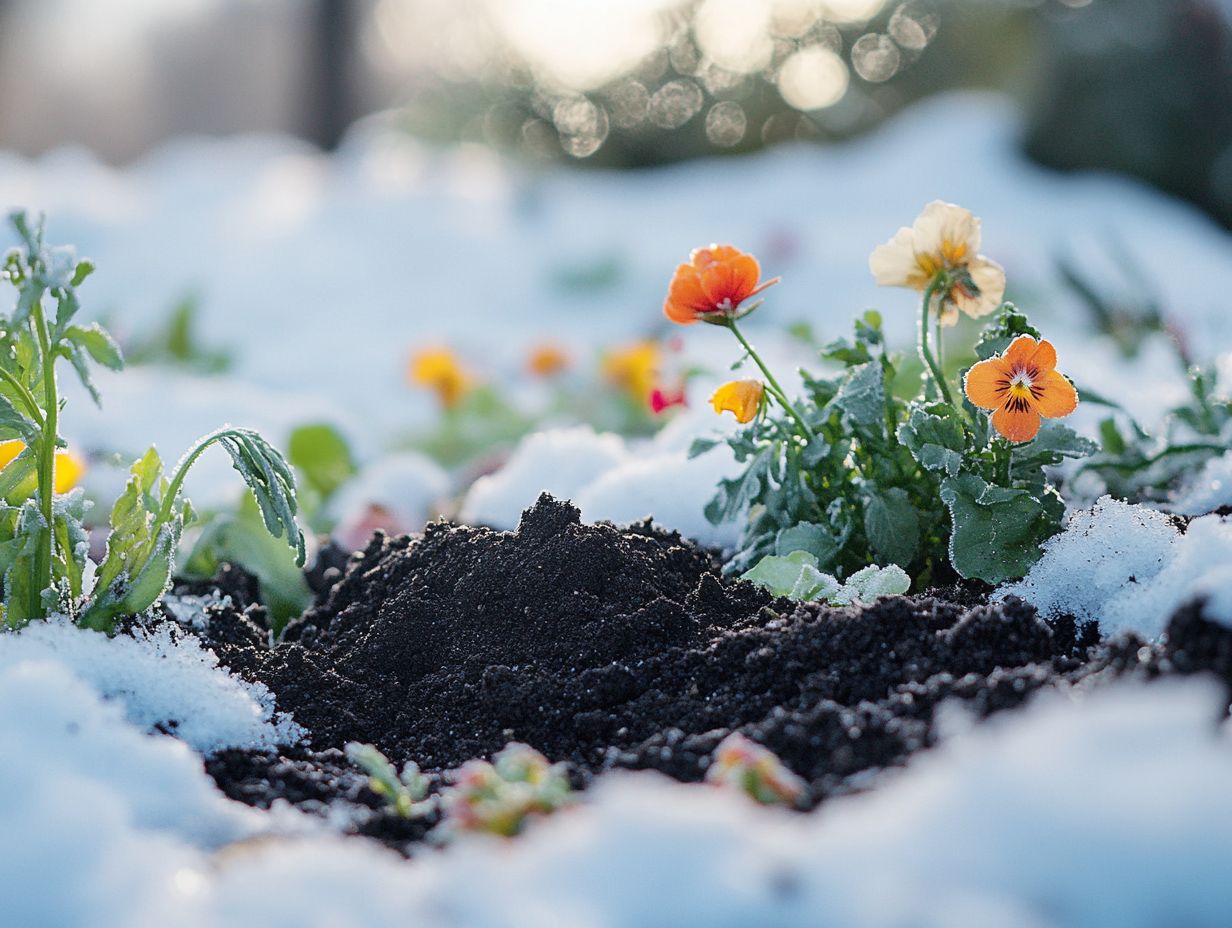
The best soil for cold-climate gardens is rich in organic matter with excellent drainage. Understanding why choose cold-climate gardening can help you select the right soil that retains moisture and nutrients while allowing excess water to escape.
What are the Benefits of Using Organic Matter in Cold-Climate Garden Soil?
Organic matter like compost or manure improves soil structure and increases nutrient content. It also helps retain moisture, which is essential for plant growth in colder climates.
How Do I Improve Drainage in Cold-Climate Garden Soil?
To enhance drainage, add materials like sand or gravel, or organic options such as compost and peat moss. These will break up heavy soils, allowing water to flow better.
Can I Use Regular Potting Soil in a Cold-Climate Garden?
Regular potting soil isn’t ideal for cold-climate gardens as it can compact and retain too much moisture. Instead, use a specialized cold-climate mix or create one using organic and non-organic materials. For more detailed information, check out what to know about soil fertility in cold climates.
What Should I Consider When Choosing Soil for a Cold-Climate Garden?
When selecting soil, consider your plants’ water and nutrient needs, sunlight exposure, and drainage capabilities. Performing a soil test can also help determine its pH and nutrient levels.
Is It Possible to Grow a Successful Garden in Cold Climates?
Absolutely! You can successfully grow a vibrant garden in cold climates with the right soil and plant choices. Choose cold-hardy plants and use the best soil for thriving even in chilly temperatures.

